Eric Case Study: Mental Health Condition, Signs, Symptoms, Aetiology, Health Promotion, Recovery
VerifiedAdded on 2023/04/07
|6
|1580
|440
AI Summary
This case study focuses on the mental health condition of Eric, including signs, symptoms, aetiology, and health promotion and recovery concepts. It analyzes the symptoms to determine the type of mental condition affecting Eric and discusses possible causes and interventions for health promotion and recovery.
Contribute Materials
Your contribution can guide someone’s learning journey. Share your
documents today.
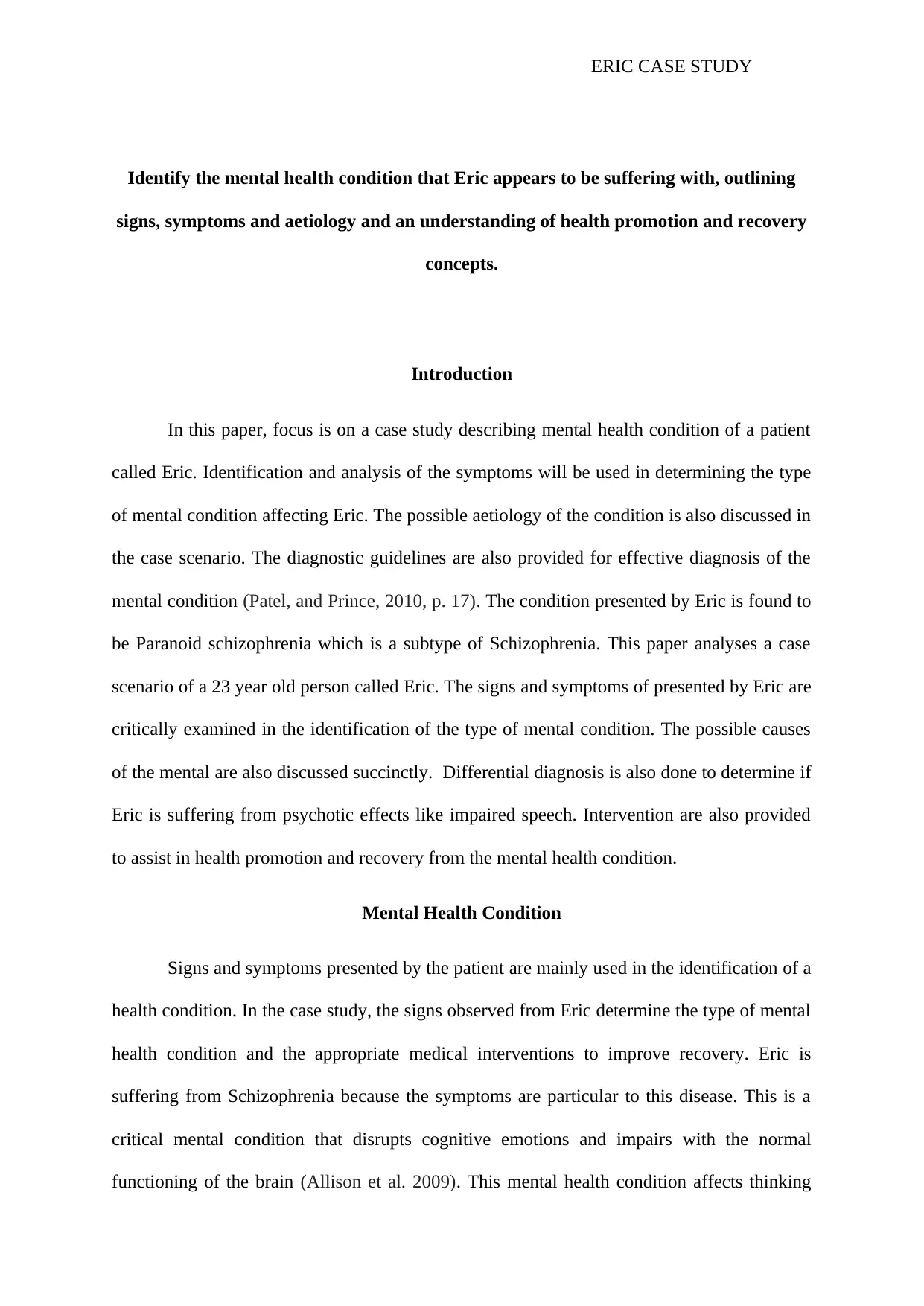
ERIC CASE STUDY
Identify the mental health condition that Eric appears to be suffering with, outlining
signs, symptoms and aetiology and an understanding of health promotion and recovery
concepts.
Introduction
In this paper, focus is on a case study describing mental health condition of a patient
called Eric. Identification and analysis of the symptoms will be used in determining the type
of mental condition affecting Eric. The possible aetiology of the condition is also discussed in
the case scenario. The diagnostic guidelines are also provided for effective diagnosis of the
mental condition (Patel, and Prince, 2010, p. 17). The condition presented by Eric is found to
be Paranoid schizophrenia which is a subtype of Schizophrenia. This paper analyses a case
scenario of a 23 year old person called Eric. The signs and symptoms of presented by Eric are
critically examined in the identification of the type of mental condition. The possible causes
of the mental are also discussed succinctly. Differential diagnosis is also done to determine if
Eric is suffering from psychotic effects like impaired speech. Intervention are also provided
to assist in health promotion and recovery from the mental health condition.
Mental Health Condition
Signs and symptoms presented by the patient are mainly used in the identification of a
health condition. In the case study, the signs observed from Eric determine the type of mental
health condition and the appropriate medical interventions to improve recovery. Eric is
suffering from Schizophrenia because the symptoms are particular to this disease. This is a
critical mental condition that disrupts cognitive emotions and impairs with the normal
functioning of the brain (Allison et al. 2009). This mental health condition affects thinking
Identify the mental health condition that Eric appears to be suffering with, outlining
signs, symptoms and aetiology and an understanding of health promotion and recovery
concepts.
Introduction
In this paper, focus is on a case study describing mental health condition of a patient
called Eric. Identification and analysis of the symptoms will be used in determining the type
of mental condition affecting Eric. The possible aetiology of the condition is also discussed in
the case scenario. The diagnostic guidelines are also provided for effective diagnosis of the
mental condition (Patel, and Prince, 2010, p. 17). The condition presented by Eric is found to
be Paranoid schizophrenia which is a subtype of Schizophrenia. This paper analyses a case
scenario of a 23 year old person called Eric. The signs and symptoms of presented by Eric are
critically examined in the identification of the type of mental condition. The possible causes
of the mental are also discussed succinctly. Differential diagnosis is also done to determine if
Eric is suffering from psychotic effects like impaired speech. Intervention are also provided
to assist in health promotion and recovery from the mental health condition.
Mental Health Condition
Signs and symptoms presented by the patient are mainly used in the identification of a
health condition. In the case study, the signs observed from Eric determine the type of mental
health condition and the appropriate medical interventions to improve recovery. Eric is
suffering from Schizophrenia because the symptoms are particular to this disease. This is a
critical mental condition that disrupts cognitive emotions and impairs with the normal
functioning of the brain (Allison et al. 2009). This mental health condition affects thinking
Secure Best Marks with AI Grader
Need help grading? Try our AI Grader for instant feedback on your assignments.
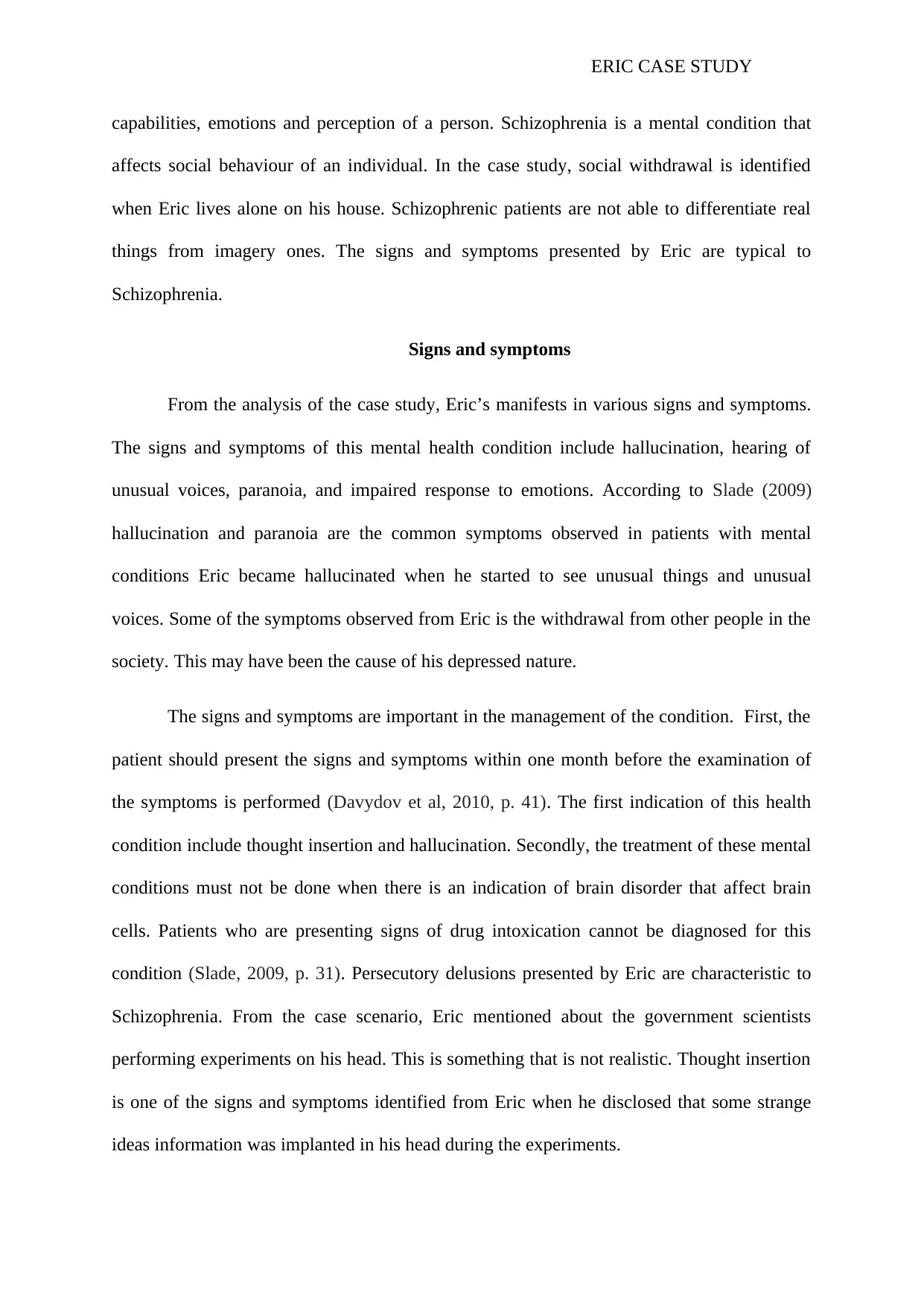
ERIC CASE STUDY
capabilities, emotions and perception of a person. Schizophrenia is a mental condition that
affects social behaviour of an individual. In the case study, social withdrawal is identified
when Eric lives alone on his house. Schizophrenic patients are not able to differentiate real
things from imagery ones. The signs and symptoms presented by Eric are typical to
Schizophrenia.
Signs and symptoms
From the analysis of the case study, Eric’s manifests in various signs and symptoms.
The signs and symptoms of this mental health condition include hallucination, hearing of
unusual voices, paranoia, and impaired response to emotions. According to Slade (2009)
hallucination and paranoia are the common symptoms observed in patients with mental
conditions Eric became hallucinated when he started to see unusual things and unusual
voices. Some of the symptoms observed from Eric is the withdrawal from other people in the
society. This may have been the cause of his depressed nature.
The signs and symptoms are important in the management of the condition. First, the
patient should present the signs and symptoms within one month before the examination of
the symptoms is performed (Davydov et al, 2010, p. 41). The first indication of this health
condition include thought insertion and hallucination. Secondly, the treatment of these mental
conditions must not be done when there is an indication of brain disorder that affect brain
cells. Patients who are presenting signs of drug intoxication cannot be diagnosed for this
condition (Slade, 2009, p. 31). Persecutory delusions presented by Eric are characteristic to
Schizophrenia. From the case scenario, Eric mentioned about the government scientists
performing experiments on his head. This is something that is not realistic. Thought insertion
is one of the signs and symptoms identified from Eric when he disclosed that some strange
ideas information was implanted in his head during the experiments.
capabilities, emotions and perception of a person. Schizophrenia is a mental condition that
affects social behaviour of an individual. In the case study, social withdrawal is identified
when Eric lives alone on his house. Schizophrenic patients are not able to differentiate real
things from imagery ones. The signs and symptoms presented by Eric are typical to
Schizophrenia.
Signs and symptoms
From the analysis of the case study, Eric’s manifests in various signs and symptoms.
The signs and symptoms of this mental health condition include hallucination, hearing of
unusual voices, paranoia, and impaired response to emotions. According to Slade (2009)
hallucination and paranoia are the common symptoms observed in patients with mental
conditions Eric became hallucinated when he started to see unusual things and unusual
voices. Some of the symptoms observed from Eric is the withdrawal from other people in the
society. This may have been the cause of his depressed nature.
The signs and symptoms are important in the management of the condition. First, the
patient should present the signs and symptoms within one month before the examination of
the symptoms is performed (Davydov et al, 2010, p. 41). The first indication of this health
condition include thought insertion and hallucination. Secondly, the treatment of these mental
conditions must not be done when there is an indication of brain disorder that affect brain
cells. Patients who are presenting signs of drug intoxication cannot be diagnosed for this
condition (Slade, 2009, p. 31). Persecutory delusions presented by Eric are characteristic to
Schizophrenia. From the case scenario, Eric mentioned about the government scientists
performing experiments on his head. This is something that is not realistic. Thought insertion
is one of the signs and symptoms identified from Eric when he disclosed that some strange
ideas information was implanted in his head during the experiments.
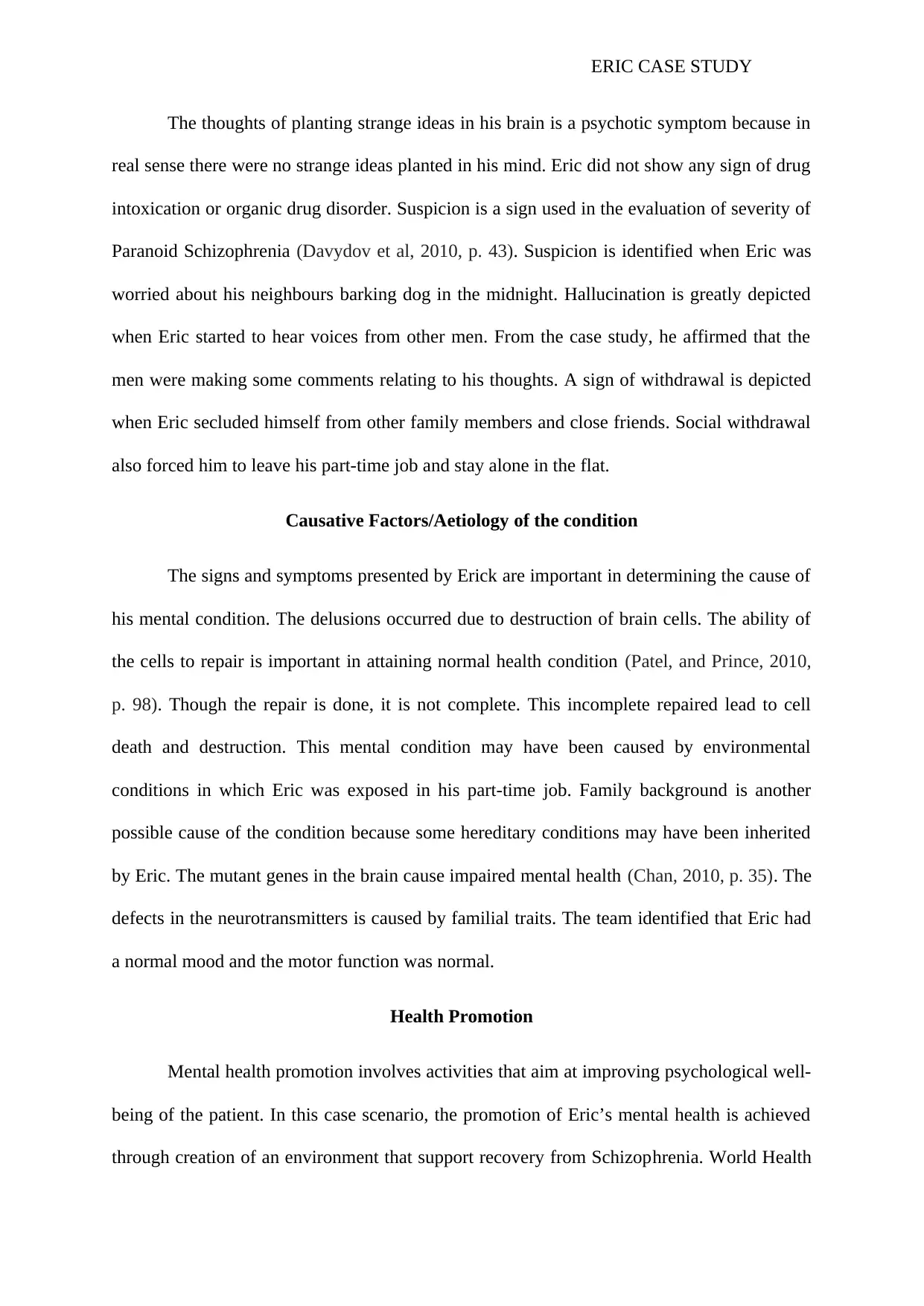
ERIC CASE STUDY
The thoughts of planting strange ideas in his brain is a psychotic symptom because in
real sense there were no strange ideas planted in his mind. Eric did not show any sign of drug
intoxication or organic drug disorder. Suspicion is a sign used in the evaluation of severity of
Paranoid Schizophrenia (Davydov et al, 2010, p. 43). Suspicion is identified when Eric was
worried about his neighbours barking dog in the midnight. Hallucination is greatly depicted
when Eric started to hear voices from other men. From the case study, he affirmed that the
men were making some comments relating to his thoughts. A sign of withdrawal is depicted
when Eric secluded himself from other family members and close friends. Social withdrawal
also forced him to leave his part-time job and stay alone in the flat.
Causative Factors/Aetiology of the condition
The signs and symptoms presented by Erick are important in determining the cause of
his mental condition. The delusions occurred due to destruction of brain cells. The ability of
the cells to repair is important in attaining normal health condition (Patel, and Prince, 2010,
p. 98). Though the repair is done, it is not complete. This incomplete repaired lead to cell
death and destruction. This mental condition may have been caused by environmental
conditions in which Eric was exposed in his part-time job. Family background is another
possible cause of the condition because some hereditary conditions may have been inherited
by Eric. The mutant genes in the brain cause impaired mental health (Chan, 2010, p. 35). The
defects in the neurotransmitters is caused by familial traits. The team identified that Eric had
a normal mood and the motor function was normal.
Health Promotion
Mental health promotion involves activities that aim at improving psychological well-
being of the patient. In this case scenario, the promotion of Eric’s mental health is achieved
through creation of an environment that support recovery from Schizophrenia. World Health
The thoughts of planting strange ideas in his brain is a psychotic symptom because in
real sense there were no strange ideas planted in his mind. Eric did not show any sign of drug
intoxication or organic drug disorder. Suspicion is a sign used in the evaluation of severity of
Paranoid Schizophrenia (Davydov et al, 2010, p. 43). Suspicion is identified when Eric was
worried about his neighbours barking dog in the midnight. Hallucination is greatly depicted
when Eric started to hear voices from other men. From the case study, he affirmed that the
men were making some comments relating to his thoughts. A sign of withdrawal is depicted
when Eric secluded himself from other family members and close friends. Social withdrawal
also forced him to leave his part-time job and stay alone in the flat.
Causative Factors/Aetiology of the condition
The signs and symptoms presented by Erick are important in determining the cause of
his mental condition. The delusions occurred due to destruction of brain cells. The ability of
the cells to repair is important in attaining normal health condition (Patel, and Prince, 2010,
p. 98). Though the repair is done, it is not complete. This incomplete repaired lead to cell
death and destruction. This mental condition may have been caused by environmental
conditions in which Eric was exposed in his part-time job. Family background is another
possible cause of the condition because some hereditary conditions may have been inherited
by Eric. The mutant genes in the brain cause impaired mental health (Chan, 2010, p. 35). The
defects in the neurotransmitters is caused by familial traits. The team identified that Eric had
a normal mood and the motor function was normal.
Health Promotion
Mental health promotion involves activities that aim at improving psychological well-
being of the patient. In this case scenario, the promotion of Eric’s mental health is achieved
through creation of an environment that support recovery from Schizophrenia. World Health
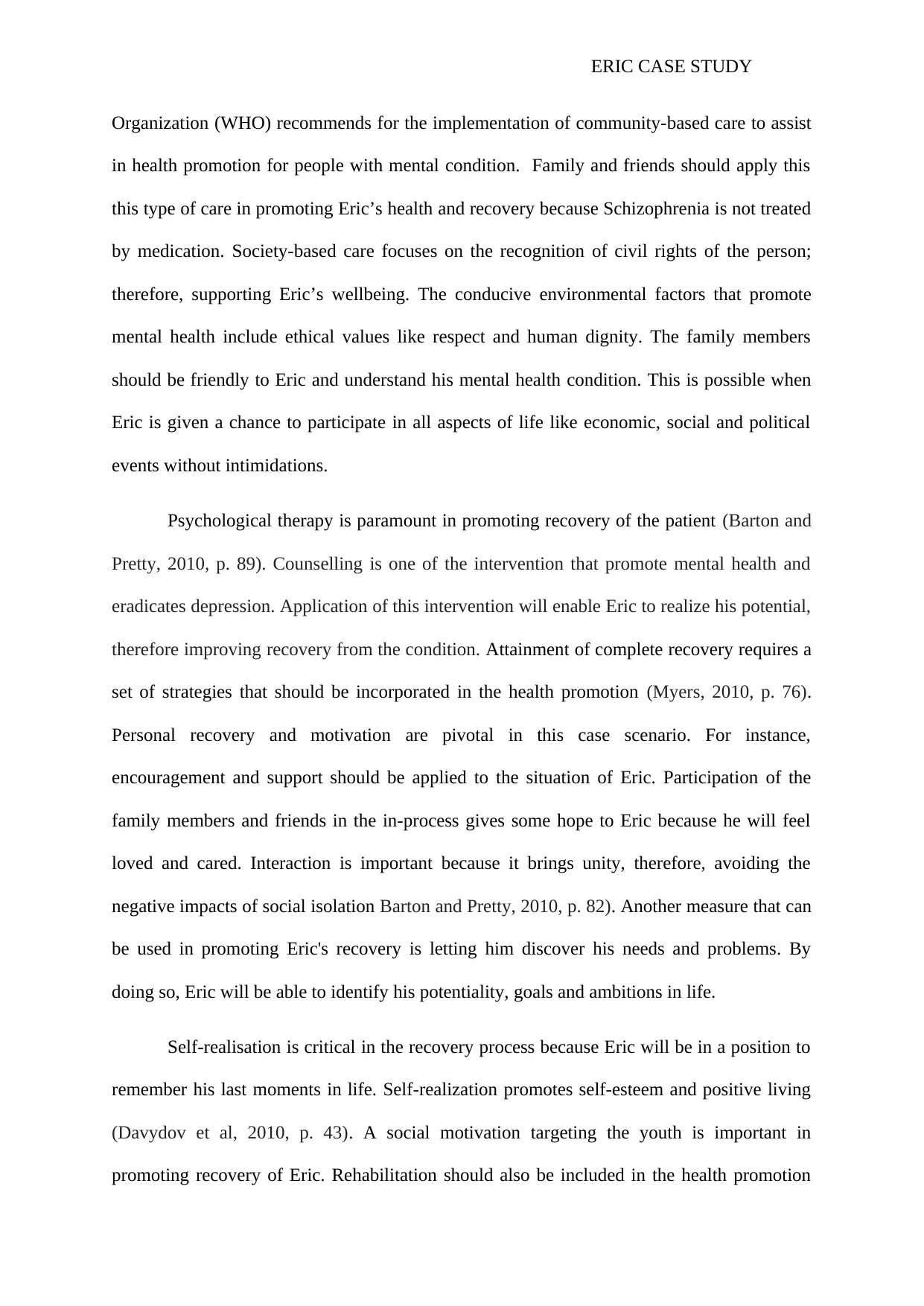
ERIC CASE STUDY
Organization (WHO) recommends for the implementation of community-based care to assist
in health promotion for people with mental condition. Family and friends should apply this
this type of care in promoting Eric’s health and recovery because Schizophrenia is not treated
by medication. Society-based care focuses on the recognition of civil rights of the person;
therefore, supporting Eric’s wellbeing. The conducive environmental factors that promote
mental health include ethical values like respect and human dignity. The family members
should be friendly to Eric and understand his mental health condition. This is possible when
Eric is given a chance to participate in all aspects of life like economic, social and political
events without intimidations.
Psychological therapy is paramount in promoting recovery of the patient (Barton and
Pretty, 2010, p. 89). Counselling is one of the intervention that promote mental health and
eradicates depression. Application of this intervention will enable Eric to realize his potential,
therefore improving recovery from the condition. Attainment of complete recovery requires a
set of strategies that should be incorporated in the health promotion (Myers, 2010, p. 76).
Personal recovery and motivation are pivotal in this case scenario. For instance,
encouragement and support should be applied to the situation of Eric. Participation of the
family members and friends in the in-process gives some hope to Eric because he will feel
loved and cared. Interaction is important because it brings unity, therefore, avoiding the
negative impacts of social isolation Barton and Pretty, 2010, p. 82). Another measure that can
be used in promoting Eric's recovery is letting him discover his needs and problems. By
doing so, Eric will be able to identify his potentiality, goals and ambitions in life.
Self-realisation is critical in the recovery process because Eric will be in a position to
remember his last moments in life. Self-realization promotes self-esteem and positive living
(Davydov et al, 2010, p. 43). A social motivation targeting the youth is important in
promoting recovery of Eric. Rehabilitation should also be included in the health promotion
Organization (WHO) recommends for the implementation of community-based care to assist
in health promotion for people with mental condition. Family and friends should apply this
this type of care in promoting Eric’s health and recovery because Schizophrenia is not treated
by medication. Society-based care focuses on the recognition of civil rights of the person;
therefore, supporting Eric’s wellbeing. The conducive environmental factors that promote
mental health include ethical values like respect and human dignity. The family members
should be friendly to Eric and understand his mental health condition. This is possible when
Eric is given a chance to participate in all aspects of life like economic, social and political
events without intimidations.
Psychological therapy is paramount in promoting recovery of the patient (Barton and
Pretty, 2010, p. 89). Counselling is one of the intervention that promote mental health and
eradicates depression. Application of this intervention will enable Eric to realize his potential,
therefore improving recovery from the condition. Attainment of complete recovery requires a
set of strategies that should be incorporated in the health promotion (Myers, 2010, p. 76).
Personal recovery and motivation are pivotal in this case scenario. For instance,
encouragement and support should be applied to the situation of Eric. Participation of the
family members and friends in the in-process gives some hope to Eric because he will feel
loved and cared. Interaction is important because it brings unity, therefore, avoiding the
negative impacts of social isolation Barton and Pretty, 2010, p. 82). Another measure that can
be used in promoting Eric's recovery is letting him discover his needs and problems. By
doing so, Eric will be able to identify his potentiality, goals and ambitions in life.
Self-realisation is critical in the recovery process because Eric will be in a position to
remember his last moments in life. Self-realization promotes self-esteem and positive living
(Davydov et al, 2010, p. 43). A social motivation targeting the youth is important in
promoting recovery of Eric. Rehabilitation should also be included in the health promotion
Secure Best Marks with AI Grader
Need help grading? Try our AI Grader for instant feedback on your assignments.
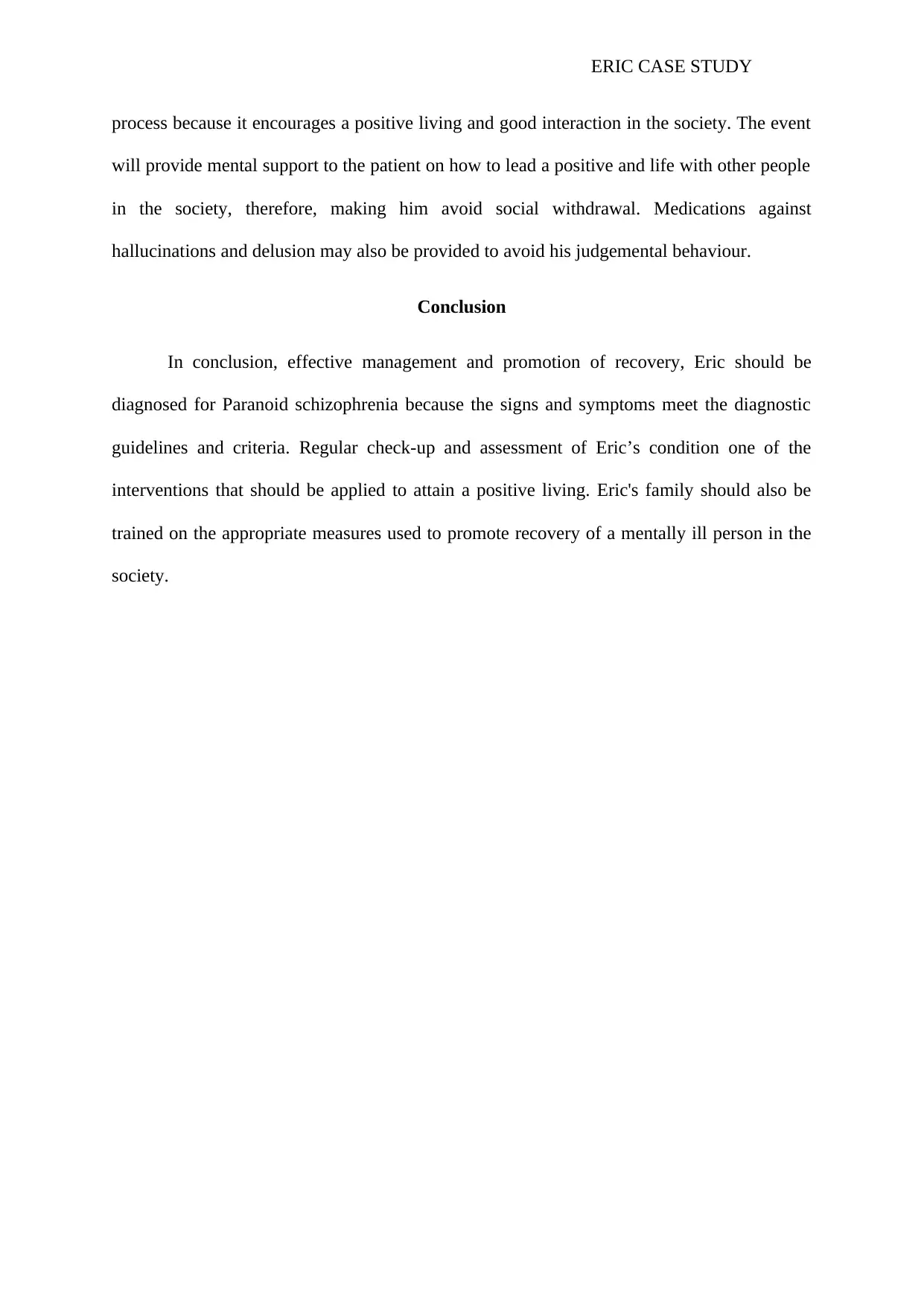
ERIC CASE STUDY
process because it encourages a positive living and good interaction in the society. The event
will provide mental support to the patient on how to lead a positive and life with other people
in the society, therefore, making him avoid social withdrawal. Medications against
hallucinations and delusion may also be provided to avoid his judgemental behaviour.
Conclusion
In conclusion, effective management and promotion of recovery, Eric should be
diagnosed for Paranoid schizophrenia because the signs and symptoms meet the diagnostic
guidelines and criteria. Regular check-up and assessment of Eric’s condition one of the
interventions that should be applied to attain a positive living. Eric's family should also be
trained on the appropriate measures used to promote recovery of a mentally ill person in the
society.
process because it encourages a positive living and good interaction in the society. The event
will provide mental support to the patient on how to lead a positive and life with other people
in the society, therefore, making him avoid social withdrawal. Medications against
hallucinations and delusion may also be provided to avoid his judgemental behaviour.
Conclusion
In conclusion, effective management and promotion of recovery, Eric should be
diagnosed for Paranoid schizophrenia because the signs and symptoms meet the diagnostic
guidelines and criteria. Regular check-up and assessment of Eric’s condition one of the
interventions that should be applied to attain a positive living. Eric's family should also be
trained on the appropriate measures used to promote recovery of a mentally ill person in the
society.
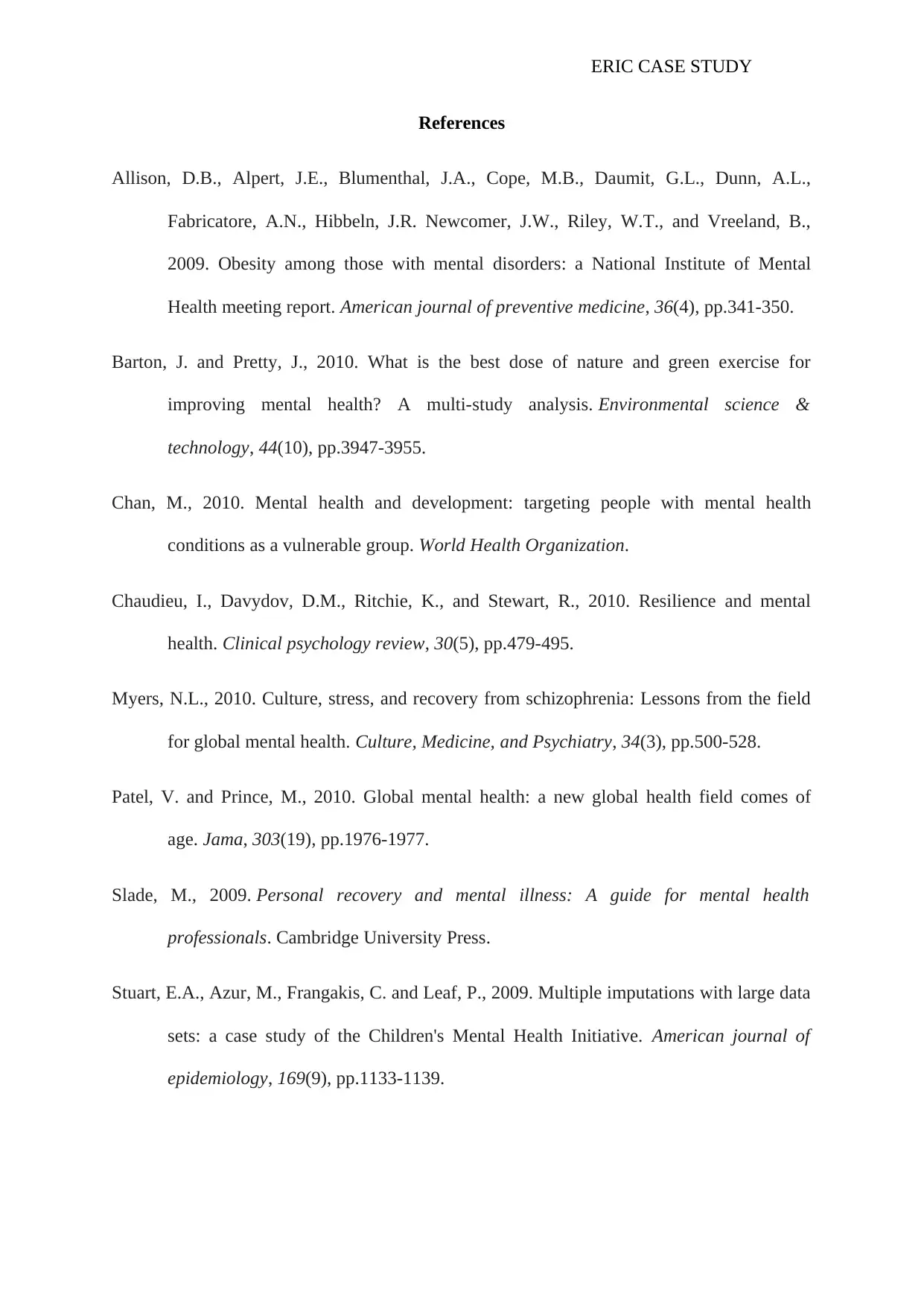
ERIC CASE STUDY
References
Allison, D.B., Alpert, J.E., Blumenthal, J.A., Cope, M.B., Daumit, G.L., Dunn, A.L.,
Fabricatore, A.N., Hibbeln, J.R. Newcomer, J.W., Riley, W.T., and Vreeland, B.,
2009. Obesity among those with mental disorders: a National Institute of Mental
Health meeting report. American journal of preventive medicine, 36(4), pp.341-350.
Barton, J. and Pretty, J., 2010. What is the best dose of nature and green exercise for
improving mental health? A multi-study analysis. Environmental science &
technology, 44(10), pp.3947-3955.
Chan, M., 2010. Mental health and development: targeting people with mental health
conditions as a vulnerable group. World Health Organization.
Chaudieu, I., Davydov, D.M., Ritchie, K., and Stewart, R., 2010. Resilience and mental
health. Clinical psychology review, 30(5), pp.479-495.
Myers, N.L., 2010. Culture, stress, and recovery from schizophrenia: Lessons from the field
for global mental health. Culture, Medicine, and Psychiatry, 34(3), pp.500-528.
Patel, V. and Prince, M., 2010. Global mental health: a new global health field comes of
age. Jama, 303(19), pp.1976-1977.
Slade, M., 2009. Personal recovery and mental illness: A guide for mental health
professionals. Cambridge University Press.
Stuart, E.A., Azur, M., Frangakis, C. and Leaf, P., 2009. Multiple imputations with large data
sets: a case study of the Children's Mental Health Initiative. American journal of
epidemiology, 169(9), pp.1133-1139.
References
Allison, D.B., Alpert, J.E., Blumenthal, J.A., Cope, M.B., Daumit, G.L., Dunn, A.L.,
Fabricatore, A.N., Hibbeln, J.R. Newcomer, J.W., Riley, W.T., and Vreeland, B.,
2009. Obesity among those with mental disorders: a National Institute of Mental
Health meeting report. American journal of preventive medicine, 36(4), pp.341-350.
Barton, J. and Pretty, J., 2010. What is the best dose of nature and green exercise for
improving mental health? A multi-study analysis. Environmental science &
technology, 44(10), pp.3947-3955.
Chan, M., 2010. Mental health and development: targeting people with mental health
conditions as a vulnerable group. World Health Organization.
Chaudieu, I., Davydov, D.M., Ritchie, K., and Stewart, R., 2010. Resilience and mental
health. Clinical psychology review, 30(5), pp.479-495.
Myers, N.L., 2010. Culture, stress, and recovery from schizophrenia: Lessons from the field
for global mental health. Culture, Medicine, and Psychiatry, 34(3), pp.500-528.
Patel, V. and Prince, M., 2010. Global mental health: a new global health field comes of
age. Jama, 303(19), pp.1976-1977.
Slade, M., 2009. Personal recovery and mental illness: A guide for mental health
professionals. Cambridge University Press.
Stuart, E.A., Azur, M., Frangakis, C. and Leaf, P., 2009. Multiple imputations with large data
sets: a case study of the Children's Mental Health Initiative. American journal of
epidemiology, 169(9), pp.1133-1139.
1 out of 6
Related Documents
Your All-in-One AI-Powered Toolkit for Academic Success.
+13062052269
info@desklib.com
Available 24*7 on WhatsApp / Email
![[object Object]](/_next/static/media/star-bottom.7253800d.svg)
Unlock your academic potential
© 2024 | Zucol Services PVT LTD | All rights reserved.





